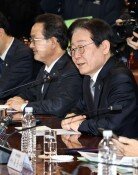Relics of Goryeo dynasty unearthed in Ganghwa Island
Relics of Goryeo dynasty unearthed in Ganghwa Island
Posted June. 04, 2019 07:37,
Updated June. 04, 2019 07:37

Artifacts revealing the Goryeo dynasty’s funeral culture such as an iron incense burner and an aminal-shaped stone statue have been discovered in the eastern part of the tomb of King Huijong (Historical site No. 369), Goryeo’s 21st monarch who reigned from 1204 to 1211, in Ganghwa Island, Incheon.
The Ganghwa National Research Institute of Cultural Heritage said Monday that it has excavated relics as a result of its two-month-long investigation into the ancient tombs. They include a leg of an iron incense burner, a pottery pot, stone statutes in the shape of a sheep and a tiger, and a stone statue in the shape of a civil servant or a military officer.
The pottery pot has a wide mouth and body with its neck being short, a typical style of the Goryeo dynasty’s pottery. The research institute explained that the pot and the animal-shaped iron incense burner are assumed to have been buried under the ground as a prayer for the safety of a structure to be built on the spot.
King Huijong was forced into exile after he failed to remove Choe Chung-heon, a military leader who had held political power from Huijong’s father Sinjong (who reigned from 1197 to 1204), and was buried in Ganghwa Island. The Goryeo dynasty, five years before Huijong passed away, moved its capital to Ganghwa to avoid an invasion of Mongolia. The island remained as the capital of Goryeo for 39 years since then.
Won-Mo Yu onemore@donga.com






